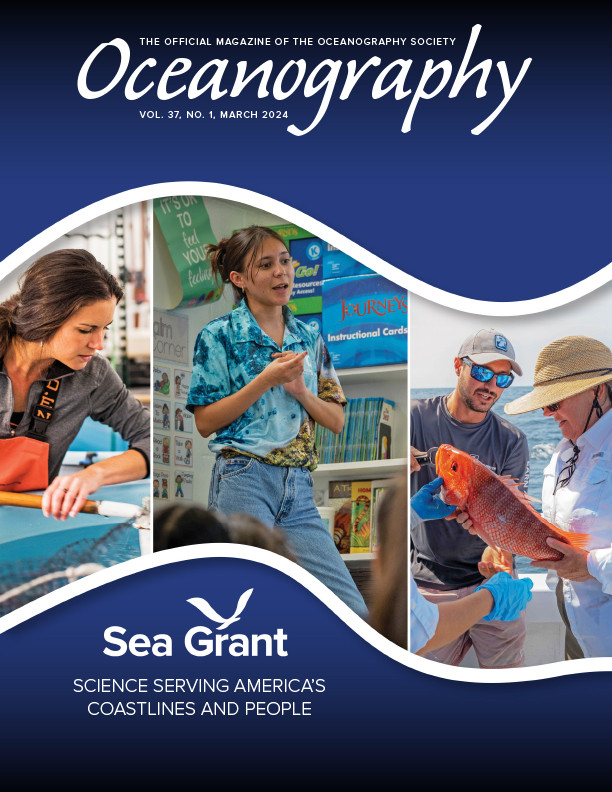Full Text
In the not-so-distant future, it may be entirely possible for an aquaculture farmer to harvest robust crops of seaweeds and shellfish safely within the leased area of an offshore wind farm. Likewise, a charter boat captain may tap into turbine sensors for weather and traffic data needed to navigate a boatload of recreational anglers to productive fishing grounds. Or, perhaps, commercial fishermen deploy innovative gear types on modified vessels to safely and lucratively fish within wind farms.
These scenarios illustrate the potential for multi-use (MU) planning approaches in ocean settings; they demonstrate purposeful and synergistic pairings of activities designed to provide benefits to each, rather than compete against one another. Thus, one day, a marine farmer, commercial fisherman, or a charter captain could potentially save time and make money by using information collected by sophisticated instrumentation located on turbines and in leased areas. Wind farms, potentially, could enhance their community visibility via partnerships that embrace turbine infrastructure as scaffolding for ocean food production. And ultimately, the information gained from sensors and community science efforts could inform the monitoring of turbines and improve our ability to adapt this ocean activity within ocean and environmental management contexts.
With growing interest and investment in promoting MU in ocean spaces the world over, definitions and visions for the approach vary. Generally, the accepted definition is the joint use of resources in close geographic proximity by either a single user or multiple users (Schupp et al., 2019). Multi-use takes place among myriad combinations of marine uses, from the interweaving of wind and wave energy technologies to the reconversion of decommissioned oil and gas platforms into renewable energy platforms or artificial reefs. Even more broadly, it can combine fishing-based tourism, aquaculture, or appropriate fishing methods safely within offshore wind farms (Lukic et al., 2024). In terms of a land-based example, MU is consistent with US Environmental Protection Agency smart growth approaches calling for synergistic mixed land uses and balancing sustainable economic, environmental, and cultural goals.
|
|
Multi-Use Testing, Assessing, Learning, and Priorities
The Northeast has its own MU process to share with the world. With funding from the National Science Foundation and the Bureau of Ocean Energy Management, a Sea Grant/Coastal Resources Center effort is assisting Rhode Island and Northeast region ocean collaborators to flex their cooperative MU muscles as one of the five multi-use case studies undertaken by the global Belmont Forum MULTIFRAME initiative. The case study involves committed research funding and carefully designed facilitations that enable government regulators, coastal and ocean practitioners, academics and students, community members, advocacy groups, and representatives of a broad range of coastal and ocean industries—from offshore wind energy developers and commercial fishers to marine farmers and port operators—to begin thoughtful, if often difficult, conversations envisioning an MU future for the Northeast. Dialogue at these forums is rich and provocative, with participants who represent many viewpoints nonetheless agreeing that existing regulatory, policy, and economic frameworks largely fail to provide a path forward in terms of supporting and incentivizing the collaborative implementation of MU. In addition, MU planning remains one of the most likely and key solutions necessary to answer food and energy needs for both the United States and the world.
While the conditions that enable implementation of MU within the context of the accelerated growth of offshore wind development are weak, this initiative has identified priority actions that would strengthen these opportunities. More must be done to proactively provide resources to primary industries, such as offshore wind energy and commercial fishing, to ensure they can invest the considerable time and energy needed to work together to find nexus points as well as to fund long-term monitoring and critical research, including, for example, determining how to modify commercial fishing vessels and gear so vital harvesting can continue to take place within wind farms.
Implementation of MU in the Future
Progress is being made toward implementing these priorities. For example, legislation has been introduced in the US Congress to improve permitting, coordination, and cooperation among agencies, offshore wind energy developers, and a spectrum of stakeholders in this arena. The COLLABORATE (Create Offshore Leadership and Livelihood Alignment By Operating Responsibly And Together for the Environment) Act, by expressing a need for efficiency and effectiveness within the offshore wind energy development process, could widen opportunities for connection to other marine activities and uses. In addition, establishment of the Cooperative Research and Development Agreement between NOAA and the University of Rhode Island is advancing collaborative research on and ocean planning solutions to the interactions of offshore wind energy development and other maritime uses. Coastal and ocean researchers and practitioners increasingly recognize that while challenges to integrating marine uses exist, opportunity is available as well. By engaging in knowledge building, learning from European experiences, and testing our own tailored solutions, science-informed MU steps can be taken to greatly leverage and improve how we use, manage, and protect our ocean spaces.


